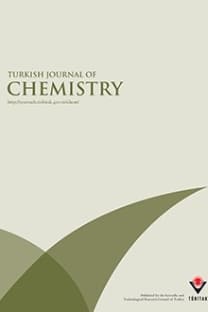Synthesis and Biological Activities of N-Alkyl Derivatives of o-, m-, and p-Nitro (E)-4-Azachalcones and Stereoselective Photochemistry in Solution, with Theoretical Calculations
Nitro-(E)-4-azachalcones, nitro-(E)-N-decyl-4-azachalconium bromide, photodimerisation, antimicrobial and antioxidant activities
Synthesis and Biological Activities of N -Alkyl Derivatives of o-, m-, and p-Nitro (E)-4-Azachalcones and Stereoselective Photochemistry in Solution, with Theoretical Calculations
Nitro-(E)-4-azachalcones, nitro-(E)-N-decyl-4-azachalconium bromide, photodimerisation, antimicrobial and antioxidant activities,
___
- J.B. Harborne, “The Flavonoids, Advances in Research”, Chapman & Hall, New York NY, 329-388, 1988.
- J.P.J. Marais, D. Ferreira and D. Slade, Phytochemistry 66, 2145-2176 (2005).
- Z. Nowakowska, E. Wyrzykiewicz and B. Kedzia, Il Farmaco 56, 325–329 (2001).
- M.L. Edwards, D.M. Stemarick, J.S. Sabol, K.A. Diekema and R.J. Dinerstein, J. Med. Chem. 37, 4357-4362 (1994).
- M. D’Auira and R. Racioppi, Tetrahedron 53, 17307-17316 (1997).
- M. D’Auria, L. Emanuele, V. Esposito and R. Racioppi, Arkivoc (xi), 65-78 (2002).
- M. D’Auria, Heterocycles, 54, 475-496 (2000).
- M. D’Auria, L. Emanuele, G. Mauriello and R. Racioppi, J. Photochem. Photobiol. A, 134, 147-154 (2000).
- N. Yaylı, A. Ya¸sar, O. ¨U¸c¨unc¨u, S. ¨O. Sivrikaya, C. G¨ule¸c, M. K¨u¸c¨uk and R. Abbasov, J. Photochem. Photobiol. A, 175, 291-298 (2005).
- N. Yaylı, O. ¨U¸c¨unc¨u, A. Ya¸sar, Y. G¨ok, M. K¨u¸c¨uk and S. Kolaylı, Tu rk. J. Chem., 28, 515-521 (2004).
- N. Yaylı, O. ¨U¸c¨unc¨u, E. Aydın, Y. G¨ok, A. Ya¸sar, C. Baltacı, N. Yıldırım and M. K¨u¸c¨uk, J. Photochem. Photobiol. A, 169, 229-234 (2005).
- V. Seidel, F. Bailleul and P.G. Waterman, Phytochemistry 55, 439-446 (2000).
- D.R. Katerere, A.I. Gray, A.R. Kennedy, R.J. Nash and R.D. Waigh, Phytochemistry 65, 433-438 (2004).
- M. D’Auria and R. Racioppi, J. Photochem. Photobiol. A, 112, 145-148 (1998).
- J. Durinda, L. Szucs, J. Kolena, A. Nagy, E. Misikova and J. Heger, Czech. Cesko-Slov. Farmac. 26, 140-149 (1977).
- V.L. Aeppli, K. Bernuuer, F. Schneider, K. Strub, W.E. Oberhansli and K.H. Pfoertner, Helv. Chim. Acta , 630-644 (1980).
- Z. Zhang, Y.W. Dong and G.W. Wang, Chem. Lett. 32, 966-967 (2003).
- Z. Nowakowska, E. Wyrzykiewicz and B. Kedzia, Il Farmaco 57, 657–661 (2002).
- Z. Nowakowska, Magn. Reson. Chem. 38, 382–383 (2000).
- B.Z. Jovanovi´c, M.M. Vukovi´c, A.D. Marinkovi´c and J. Csan´adi, J. Mol. Struct. 482-483, 371-374 (1999).
- National Committee for Clinical Laboratory Standard, NCCLS Document M7-A3, 13 (25), Willanova, PA., USA, 1993.
- M. Cuendet, K. Hostettmann and O. Potterat, Helv. Chim. Acta 80, 1144-1152 (1997).
- ISSN: 1300-0527
- Yayın Aralığı: 6
- Yayıncı: TÜBİTAK
Chemical Constituents of Galium tortumense
Zühal GÜVENALP, Nurcan KILIÇ, Cavit KAZAZ
Osman ÜÇÜNCÜ, Murat KÜÇÜK, Nurettin YAYLI, Emine AKYÜZ, Ahmet YAŞAR, Alpay Şengül KARAOĞLU, Nuran YAYLI
Sajjad AHMED, Moazzam Hussain BHATTI
Trace Element Determination in Brassica oleraceae var. acephale by Differential Pulse Polarography
Güler SOMER, Arzu NAKIŞCI ÜNLÜ, Şükrü KALAYCI, Ferat ŞAHİN
Optical Fluoride Sensing with a Bay Region Functionalized Perylenediimide Dye
Terpenic and Phenolic Compounds from Sideritis stricta
F. Pınar ŞAHİN, Nurten EZER, İhsan ÇALIŞ
Antioxidant Activities of the Extracts and Components of Teucrium orientale L. var. orientale
